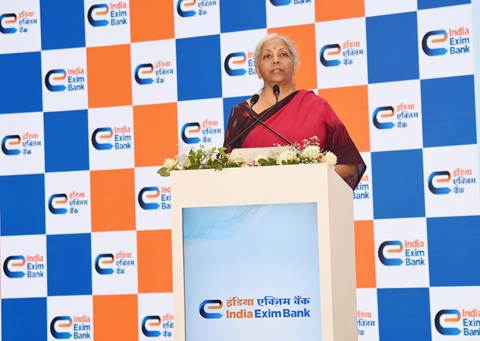
India is not a tariff king : Nirmala Sitharaman
NEW DELHI : Finance Minister Smt Nirmala Sitharaman on Tuesday rebutted the label of “tariff king” often used by US President Donald Trump for India, and said the country’s effective tariff rates are far lower than they appear.
Speaking at the Exim Bank Trade Conclave 2025 in the capital, the minister said India seeks parliamentary approval for setting tariffs at a certain level, but the effective rates notified are much lower than the ceiling approved. This creates the impression abroad that India’s tariffs are high.
President Trump, who imposed a now-suspended 26% reciprocal tariff on Indian exports, first called India “tariff king” during his first term in 2019, and subsequently this year in February. The universal 10% baseline tariff imposed by the US on all imports into its soil is now applicable to Indian exports as well.
The US administration determined reciprocal tariffs on each country by dividing its own trade deficit with the exporting country by the total exports of that country into the US, then turning it into a percentage figure and dividing it by two, which many critics called “overly simplistic”.
Sitharaman’s explanation of India’s tariff procedures comes at a time New Delhi and Washington are in the last leg of a trade negotiation to avoid the 26% reciprocal tariff the Trump administration announced in April, which has been suspended till 9 July to facilitate trade talks. “Negotiations are intensely going on,” the minister said.
Sitharaman also said Indian exports are doing well despite mounting challenges in the global trade scenario. The minister said those who believe in the US’ commentary that India is the tariff king, should understand the way tariffs are given effect in India.
Sitharaman said in the Indian system, the government secures Parliament’s approval for setting tariffs at a certain level, but effectively, it is implemented at a far lower level.
“The effective tariff rate is at a far lower level. But what gets published in the Gazette would be the level for which you obtain permission from the Parliament. And it is that level which appears everywhere and people then tend to think, probably rightly, that is the rate at which we are imposing tariffs,” the minister said.
The procedures have given rise to the “not-so-desirable picture of being very restrictive and regressive about tariff,” Sitharaman said. The minister added that many goods have tariffs lower than the rate cleared by Parliament. In addition, the government removed seven tariff rates, reducing the total to just eight. “So, for those of us who still think there’s something about the tariff story in India, I want this to be clear. There are only eight rates, including the zero rate,” the minister said, adding that India has introduced a lot of reforms to support manufacturing and domestic value addition, promote exports and facilitate trade.
Challenges are mounting for Indian exporters, but the government’s targeted measures are helping, Sitharaman added.
India’s production-linked incentive (PLI) schemes have transformed its export basket from traditional commodities to high-value-added products, she said.
In FY25, India’s total exports reached an all-time high of $825 billion, achieving 6% growth over the previous year, and a significant leap from the $466 billion in 2013–14, the minister pointed out.
India has deepened participation in global value chains, the minister said, adding that Apple India’s iPhone contract manufacturers have crossed the 20% domestic value addition (DVA) threshold across variants.
Source : Mint
